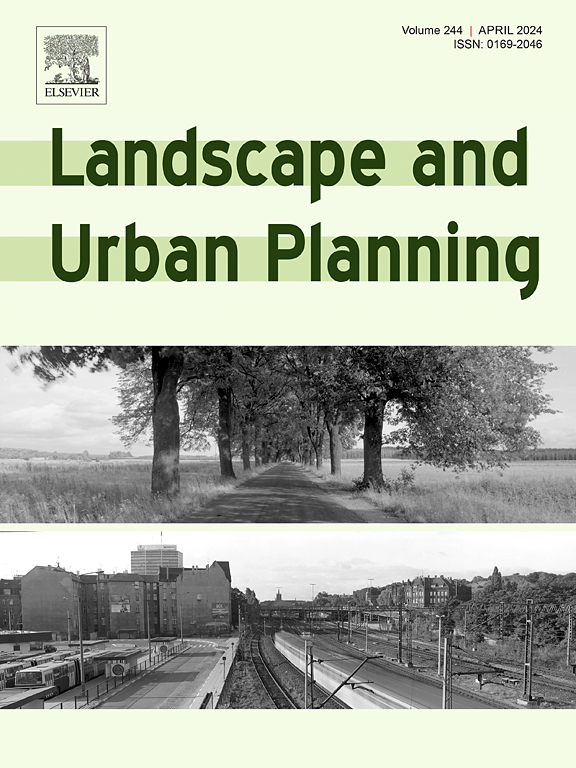Sub-parcel scale analysis is needed to capture socially-driven canopy cover change in Baltimore, MD
IF 7.9
1区 环境科学与生态学
Q1 ECOLOGY
引用次数: 0
Abstract
Urban tree canopy (UTC) cover is rarely distributed equitably across social groups, space, and time. Over the past 20 years, research on the social, spatial, and temporal dynamics of UTC has grown considerably as municipalities adopt ambitious tree canopy cover goals. Yet less is known about how these three dimensions of tree canopy intersect. This paper brings these research areas together by examining i) which sets of social variables--population density, socioeconomic status, or lifestyle--are associated with UTC cover on residential lands, ii) how those relationships vary from front to back yard, and iii) how those relationships are associated with tree canopy cover changes in Baltimore, MD from 2013 to 2018, to more wholistically understand UTC. Socially, population density and social stratification predict tree canopy cover on residential lands, but not as well as lifestyle and life stage factors. More detailed and finer-grain social categories perform best. Spatially, models that explicitly separate front and backyards fit the data better than all-residential statistical models. Ignoring the front yard vs back yard distinction may hinder future theory development, limit the generalizability of empirical research findings, and prevent managers from realizing their canopy goals. Temporally, UTC across residential yards had a positive, though not significant, change likely from the relatively short period (5 y) considered. A fruitful next step could be to model how much planting, maintenance, and loss minimization is needed to achieve the city’s 40 % canopy goal with various scenarios for mortality, longevity, and removal over several timesteps.
要捕捉马里兰州巴尔的摩市由社会驱动的树冠覆盖变化,需要进行分地块尺度的分析
城市树冠覆盖(UTC)很少在社会群体、空间和时间上公平分布。在过去的 20 年中,随着各城市纷纷制定了宏伟的树冠覆盖目标,有关 UTC 的社会、空间和时间动态的研究也有了长足的发展。然而,人们对树冠的这三个维度如何相互交织却知之甚少。本文将这些研究领域结合在一起,研究 i)哪些社会变量集(人口密度、社会经济地位或生活方式)与住宅用地的UTC覆盖率相关;ii)这些关系如何从前院到后院发生变化;iii)这些关系如何与马里兰州巴尔的摩市2013年至2018年的树冠覆盖率变化相关联,从而更全面地了解UTC。从社会角度来看,人口密度和社会分层可以预测居住地的树冠覆盖率,但不如生活方式和生命阶段因素预测得好。更详细、更细粒度的社会类别表现最佳。在空间上,明确区分前院和后院的模型比所有住宅统计模型更适合数据。忽视前院与后院的区别可能会阻碍未来的理论发展,限制经验研究结果的推广性,并妨碍管理者实现其树冠目标。从时间上看,各住宅庭院的UTC虽然变化不大,但在相对较短的时间内(5 年)可能出现了积极的变化。下一步富有成效的工作可能是建立模型,说明需要多少种植、维护和损失最小化才能实现城市 40% 的树冠目标,并在几个时间步骤中对死亡率、寿命和移除进行各种假设。
本文章由计算机程序翻译,如有差异,请以英文原文为准。
求助全文
约1分钟内获得全文
求助全文
来源期刊

Landscape and Urban Planning
环境科学-生态学
CiteScore
15.20
自引率
6.60%
发文量
232
审稿时长
6 months
期刊介绍:
Landscape and Urban Planning is an international journal that aims to enhance our understanding of landscapes and promote sustainable solutions for landscape change. The journal focuses on landscapes as complex social-ecological systems that encompass various spatial and temporal dimensions. These landscapes possess aesthetic, natural, and cultural qualities that are valued by individuals in different ways, leading to actions that alter the landscape. With increasing urbanization and the need for ecological and cultural sensitivity at various scales, a multidisciplinary approach is necessary to comprehend and align social and ecological values for landscape sustainability. The journal believes that combining landscape science with planning and design can yield positive outcomes for both people and nature.
 求助内容:
求助内容: 应助结果提醒方式:
应助结果提醒方式:


